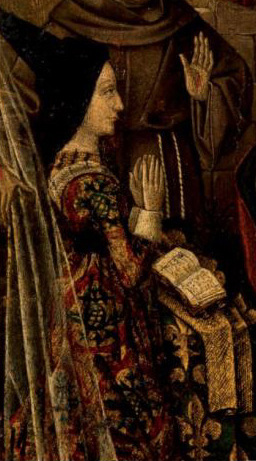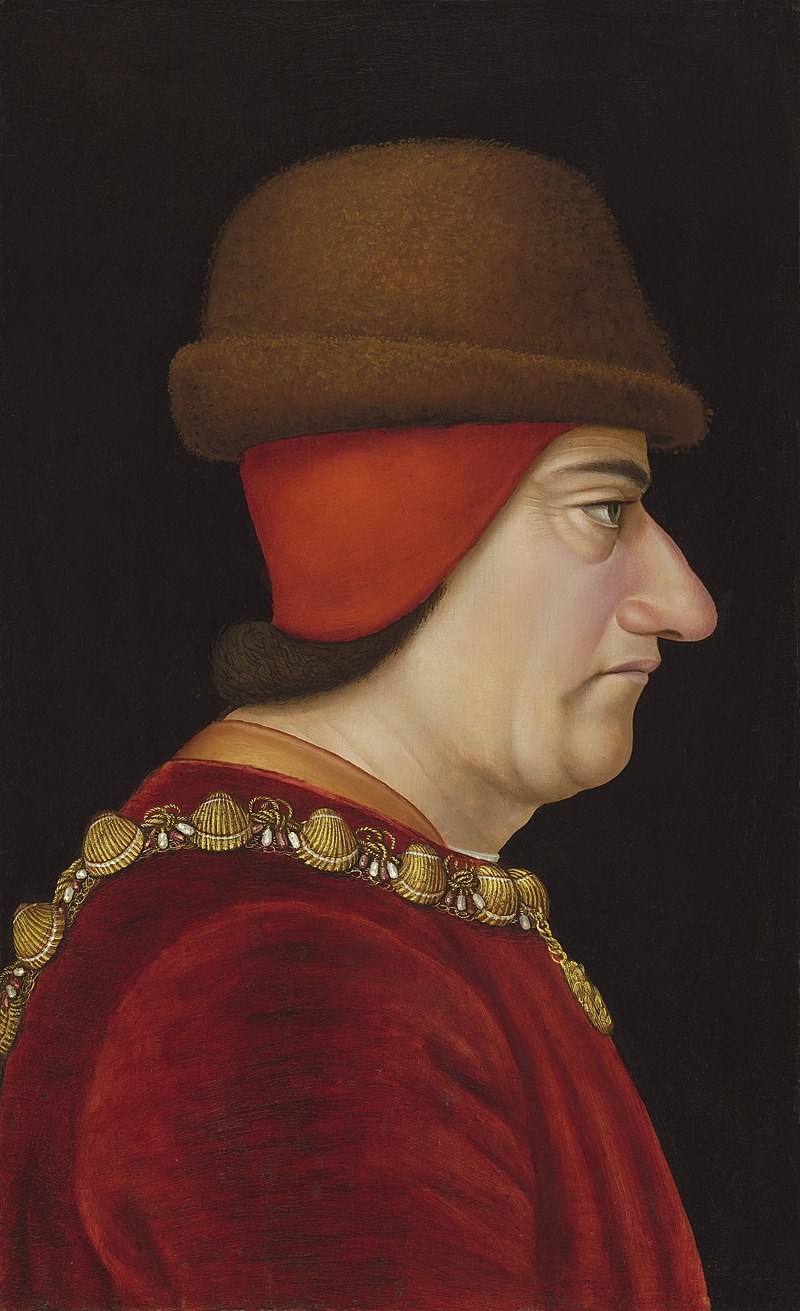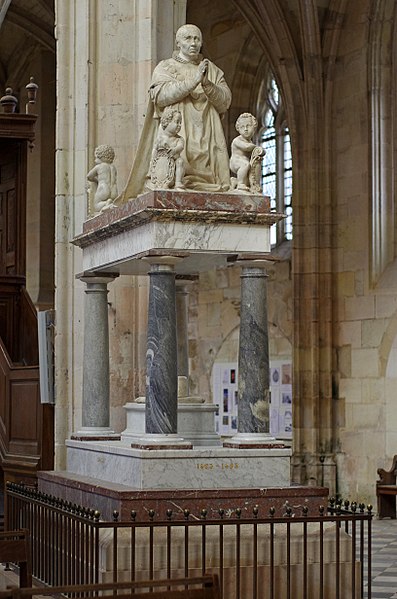
Charlotte de Savoy, a daughter of Duke Louis de Savoy and his wife, Anne of Cyprus, was born on the 11th of November 1441 or 1443. She was one of her parents’ 19 children; 14 of them survived into adulthood. Although the House of Savoy often intermarried with their French and Burgundian cousins, Louis’ union with Anne of Cyprus (Anne de Lusignan) brought some fresh blood to the family. The survival of more than half of their progeny is not surprising despite their inbreeding in the previous generations. While Charlotte’s father loved poetry and detested politics despite his title, her smart mother was actively involved in state affairs.
Two of Charlotte’s older brothers became the rulers of Savoy. They were Amadeus IX de Savoy, who was married to Yolande de Valois (one of the few surviving children of King Charles VII of France and his wife, Marie d’Anjou), and Philippe II de Savoy, who was the father of Louise de Savoy and the grandfather of King François I of France. However, the deaths of many males eventually removed the Savoy-Lusignan progeny from the ruling dynasty. Charlotte seems to have been born in Geneva, modern Switzerland. She was her parents’ 9th child and their 4th daughter. At first, Charlotte was betrothed to Frederick of Saxony, but the engagement contract was cancelled.
At the age of 9, Charlotte married the 27-year-old Dauphin Louis of France (future King Louis XI of France known as the Universal Spider, or l’universelle aragne). Louis was her Valois cousin who had a strained relationship with his father – Charles VII the Victorious (le Victorieux). Dauphin Louis was a widower, having lost his first spouse – Margaret of Scotland. Charles VII did not give his consent for the marriage of his rebellious son to a Savoy princess, but it did not change the girl’s status – Charlotte became the Dauphine of France. As Louis escaped from France and waited for his father’s passing, Charlotte spent a lot of time in the Burgundian Netherlands at the court of Philippe the Good (le Bon), Duke of Burgundy and the French ruler’s cousin.
The marriage was not consummated until Charlotte turned 15. The couple’s first son, Louis, was born in 1458 and died shortly thereafter. Her infant children, Joachim and Louise, were born and died in 1459 and 1460, respectively; Charlotte mourned for them. Far older than his young wife, Dauphin Louis did not pay much attention to her; he was a cold, calculative, and devious man. When the news of Charles VII’s death arrived at the Burgundian court, the new monarch deserted his wife and hurried to return to France to be crowned. Queen Charlotte journeyed to her new country alone with the party that Isabella de Bourbon, a second wife of Charles the Bold, Duke of Burgundy, arranged for her. In France, Charlotte settled at Château d’Amboise in the Loire Valley.

Charlotte’s first surviving child was the formidable Princess Anne, also known as Anne de Beaujeu. The baby girl was born in April 1461. Soon the queen had more children: Jeanne, born in April 1464, and short-live boys – they were both named François, born in 1466 and 1472, respectively. The only surviving son of Louis XI and Charlotte was Dauphin Charles (future Charles VIII called the Affable, or l’Affable), whose death in 1498 would lead to the extinction of the Valois senior male line. Deformed and fragile, Princess Jeanne was forced by her father to marry her cousin – Duke Louis d’Orléans (later Louis XII of France), for Louis XI aimed to terminate the Valois-Orléans line, for Jeanne was highly likely to be infertile. Ironically, Louis d’Orléans would ascend to the throne years later, and he would have his childless union with Jeanne annulled. The wife of Pierre II, Duke de Bourbon, Anne would have one surviving daughter – the sickly Suzanne de Bourbon, who would die without issue, resulting in the extinction of Charlotte’s line.

Most of the offspring of Louis XII and Charlotte were sickly and short-lived, save Anne and Charles. Why was it so? Why was their unfortunate daughter Jeanne deformed and sterile? The answer to this question is quite simple – inbreeding. Out of all the Valois lines, the senior line was the most inbred one. If you look back, more than 200-250 years of constant intermarriages with close relatives had to result in the termination of the senior line that took the brunt of Capetian and Valois inbreeding. Louis XII’s parents, who were 2nd cousins, also had reproductive problems: Charles VII of France and Marie d’Anjou buried 9 out of their 14 children, and 3 of them died young without legitimate issue. Louis and Charlotte’s reproductive misfortunes mirrored those of Louis’ parents.
Philippe VI of France, called the Fortunate (le Fortuné), inherited the throne in 1428. At the time, the Valois senior line was already inbred: Philippe VI’s parents – Count Charles de Valois and Countess Marguerite d’Anjou – were double second cousins. Philippe married his 2nd cousin – Jeanne of Burgundy known as the Lame Queen (Jeanne la Boiteuse). Philippe and Jeanne were both descended from Louis IX of France (Saint Louis) and from earlier Capetian monarchs on paternal and maternal sides, so it is no wonder that out of their 9 children, only 2 of them survived infancy. The older son of Philippe and his wife was the incompetent King Jean II of France, one of the worst French rulers. Jean II’s only accomplishment, if it can be called so, was his marriage to Bonne de Luxembourg, who was distantly related to him and, hence, brought fresh blood to the Capetian-Valois dynasty – this allowed most of their children, including their 4 sons, to survive into adulthood and have offspring. In later centuries, the descendants of Jean II and Bonne so actively intermarried with each other that Louis XII and Queen Charlotte were bound to have reproductive problems. People who constantly marry their close relatives cannot procreate successfully for an infinite amount of time.
Charlotte de Savoy was a traditional woman and queen. Not interested in politics, she spent most of her time embroidering, going on pilgrimages, and raising her children. Ascetic and frugal, Louis XII did not hold a splendid court and dedicated his entire life to weaving webs of intrigues against his enemies. Although her marriage to Louis was not based on love, Charlotte accepted her fate with grace and saw her matrimony as her duty. Throughout the Middle Ages, women’s most important role was that of a mother and child bearer, in particular the role of a queen. Charlotte’s role in her spouse’s life can be compared to that written in the Bible – obedience, childbearing, and raising their two daughters, for Dauphin Charles was educated by his father.
Nevertheless, Louis once trusted Charlotte to act as his regent during his absence in 1465. She performed the ceremonial duties of a queen on rare occasions, for example when important foreign guests visited France. Louis and Charlotte welcomed at Amboise Richard Neville, Earl of Warwick, and George Plantagenet, Duke of Clarence and a younger brother of King Edward IV of England. For the most part, Charlotte led a quiet life in the tranquility of Amboise. Charlotte was well-educated and adored literature: there were more than one hundred manuscripts in her library. Virtuous and pious, Charlotte was a classic medieval queen, one who was respected and loved by her subjects. Even if Charlotte wanted to become a patroness of the arts, Louis XI would not have allowed her to act so because he was not interested in culture. Before his marriage to Charlotte, the monarch had mistresses (Phélisé Regnard, Marguerite de Sassenage, and others) and sired bastards. However, Louis appears to have been faithful to his spouse.

The chronicle Philippe de Commines, a writer and diplomat at the courts of Burgundy and France, described the matrimony of King Louis XI and Queen Charlotte:
“As for ladies, he [Louis XI] never meddled with any in my time; for about the time of my coming to his court he lost a son, at whose death be was extremely afflicted, and he made a vow to God in my presence never to have intercourse with any other woman but the queen; and though this was no more than what be was bound to do by the canons of the church, vet it was much that his self-command should be so great, that he should be able to persevere in his resolution so firmly, considering that the queen (though an excellent princess in other respects) was not a person in whom a man could take any great delight.”

Charlotte could not entrance a man, although she was not ugly. Louis was not a passionate lover and charmer. Therefore, the spouses had a working relationship without mutual strong affection. When Charlotte was widowed in August 1483, her husband’s will specified that she should be a member of their son’s Regency Council, but she was not made Charles VIII’s regent – her daughter, Anne de Beaujeu, and Anne’s husband, Pierre de Bourbon, performed this role. Some illness, which Charlotte had experienced years ago, weakened her health, and she outlived Louis by 4 months. At the age of 42, Charlotte passed away on the 1st of December 1483 at Château d’Amboise; she was interred with her husband in the Notre-Dame de Cléry Basilica in Cléry-Saint-André near Orléans. Charlotte and Louis are perhaps the only monarchs who were not buried in the French royal necropolis at the Basilica of Saint-Denis according to the king’s will.
All images are in the public domain.
Text © 2020 Olivia Longueville





